Justice, Change, and Ethical Clothing: A UNCC300 Report
VerifiedAdded on 2022/11/18
|7
|1488
|125
Report
AI Summary
This report, prepared for the UNCC300 course, delves into the multifaceted issues surrounding ethical clothing, examining its impact on the common good both locally (Australia) and globally. It critiques how exploitative labor practices, environmental risks, and unsustainable production methods challenge the principles of human dignity and social welfare. The report connects these issues to the broader context of Catholic Social Teaching (CST), particularly the principle of the common good. It proposes comprehensive solutions to address these challenges, advocating for strong policies to ensure safe working conditions, fair wages, and the prevention of child labor. The report also emphasizes the importance of sustainable farming practices, reducing water usage, and utilizing alternative fabrics. Furthermore, it suggests promoting recycling, ethical animal rearing, and community engagement to foster a more just and sustainable fashion industry. The analysis includes references to relevant academic literature, providing a well-researched perspective on ethical clothing and its implications for global justice.
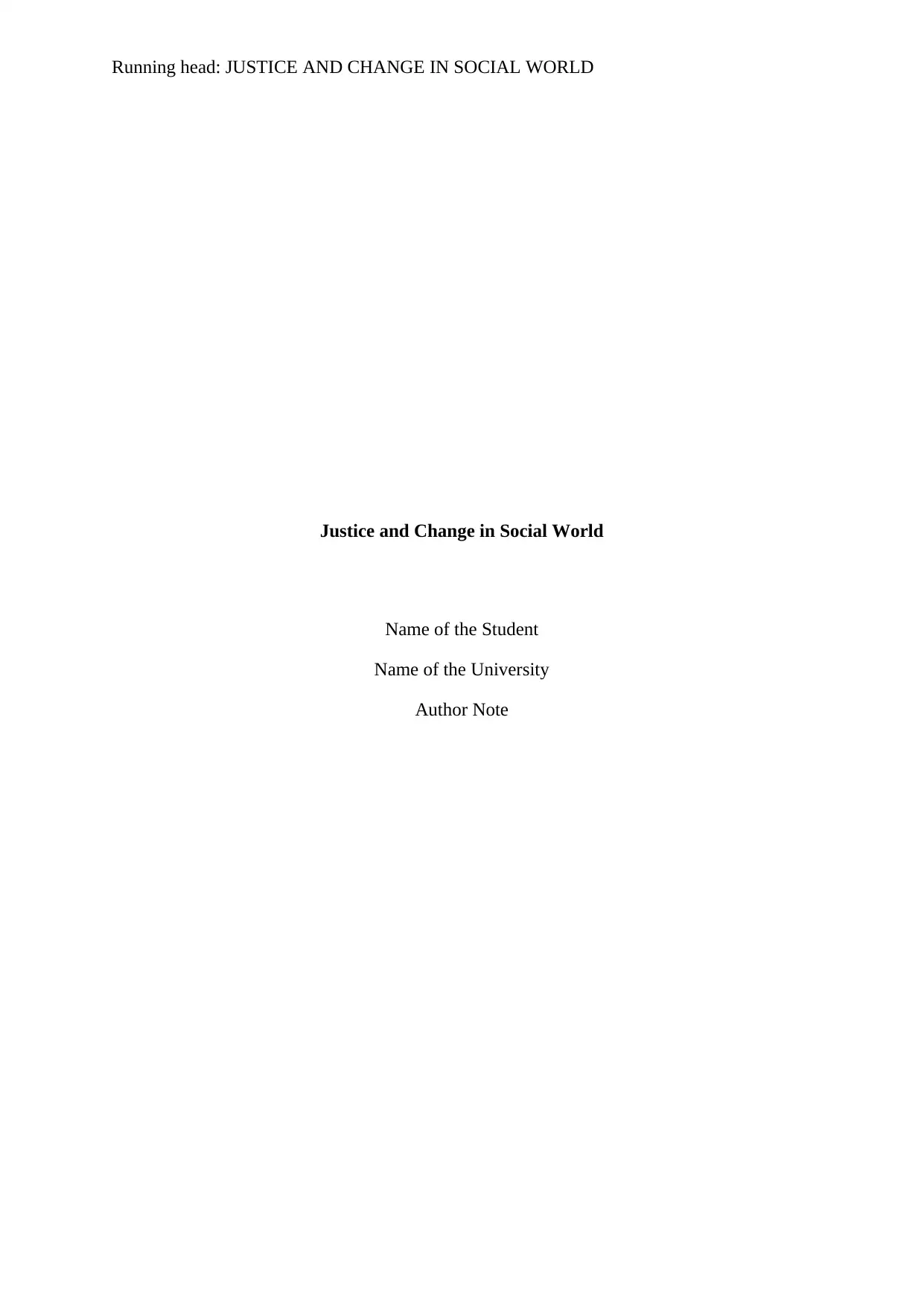
Running head: JUSTICE AND CHANGE IN SOCIAL WORLD
Justice and Change in Social World
Name of the Student
Name of the University
Author Note
Justice and Change in Social World
Name of the Student
Name of the University
Author Note
Paraphrase This Document
Need a fresh take? Get an instant paraphrase of this document with our AI Paraphraser
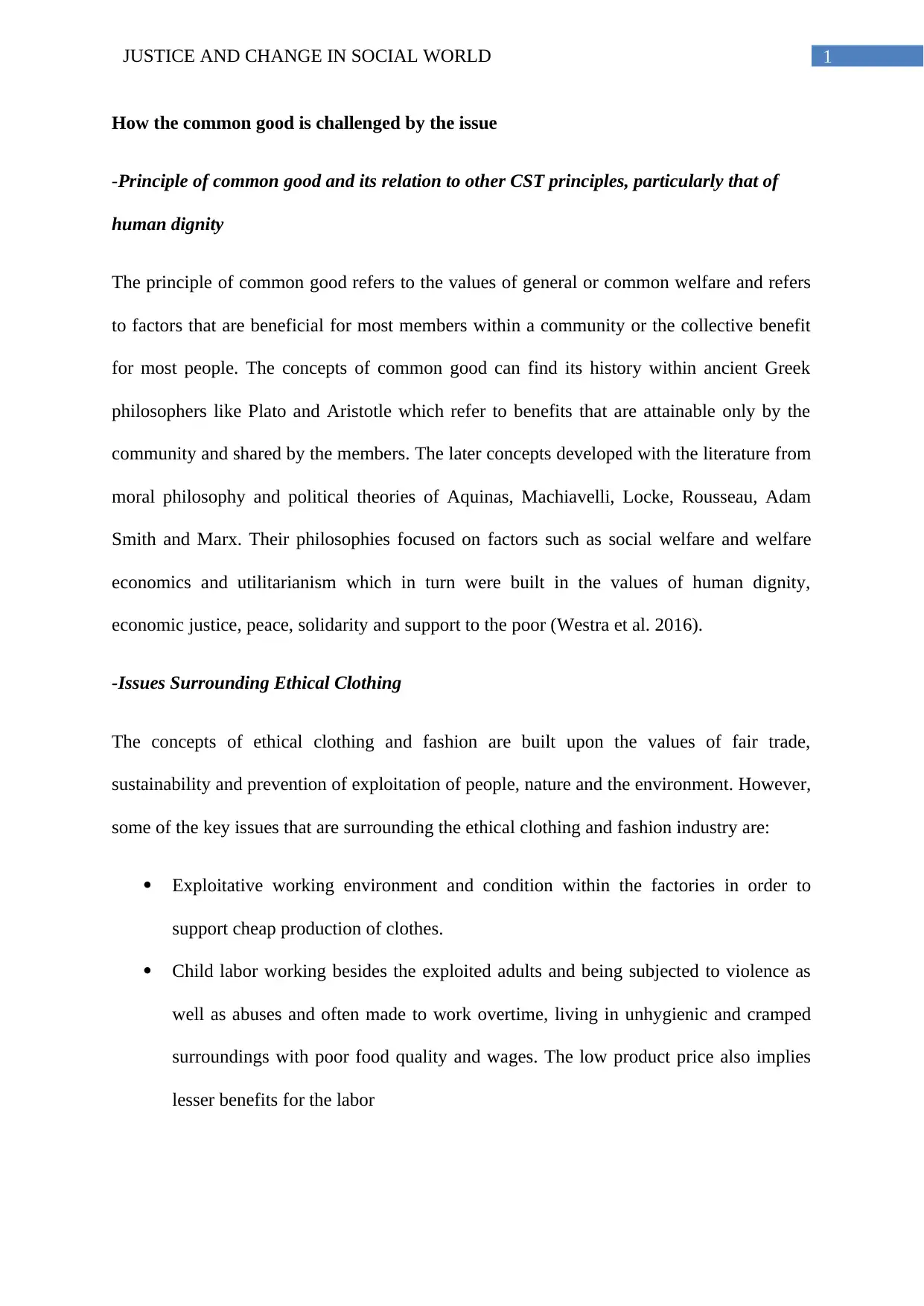
1JUSTICE AND CHANGE IN SOCIAL WORLD
How the common good is challenged by the issue
-Principle of common good and its relation to other CST principles, particularly that of
human dignity
The principle of common good refers to the values of general or common welfare and refers
to factors that are beneficial for most members within a community or the collective benefit
for most people. The concepts of common good can find its history within ancient Greek
philosophers like Plato and Aristotle which refer to benefits that are attainable only by the
community and shared by the members. The later concepts developed with the literature from
moral philosophy and political theories of Aquinas, Machiavelli, Locke, Rousseau, Adam
Smith and Marx. Their philosophies focused on factors such as social welfare and welfare
economics and utilitarianism which in turn were built in the values of human dignity,
economic justice, peace, solidarity and support to the poor (Westra et al. 2016).
-Issues Surrounding Ethical Clothing
The concepts of ethical clothing and fashion are built upon the values of fair trade,
sustainability and prevention of exploitation of people, nature and the environment. However,
some of the key issues that are surrounding the ethical clothing and fashion industry are:
Exploitative working environment and condition within the factories in order to
support cheap production of clothes.
Child labor working besides the exploited adults and being subjected to violence as
well as abuses and often made to work overtime, living in unhygienic and cramped
surroundings with poor food quality and wages. The low product price also implies
lesser benefits for the labor
How the common good is challenged by the issue
-Principle of common good and its relation to other CST principles, particularly that of
human dignity
The principle of common good refers to the values of general or common welfare and refers
to factors that are beneficial for most members within a community or the collective benefit
for most people. The concepts of common good can find its history within ancient Greek
philosophers like Plato and Aristotle which refer to benefits that are attainable only by the
community and shared by the members. The later concepts developed with the literature from
moral philosophy and political theories of Aquinas, Machiavelli, Locke, Rousseau, Adam
Smith and Marx. Their philosophies focused on factors such as social welfare and welfare
economics and utilitarianism which in turn were built in the values of human dignity,
economic justice, peace, solidarity and support to the poor (Westra et al. 2016).
-Issues Surrounding Ethical Clothing
The concepts of ethical clothing and fashion are built upon the values of fair trade,
sustainability and prevention of exploitation of people, nature and the environment. However,
some of the key issues that are surrounding the ethical clothing and fashion industry are:
Exploitative working environment and condition within the factories in order to
support cheap production of clothes.
Child labor working besides the exploited adults and being subjected to violence as
well as abuses and often made to work overtime, living in unhygienic and cramped
surroundings with poor food quality and wages. The low product price also implies
lesser benefits for the labor
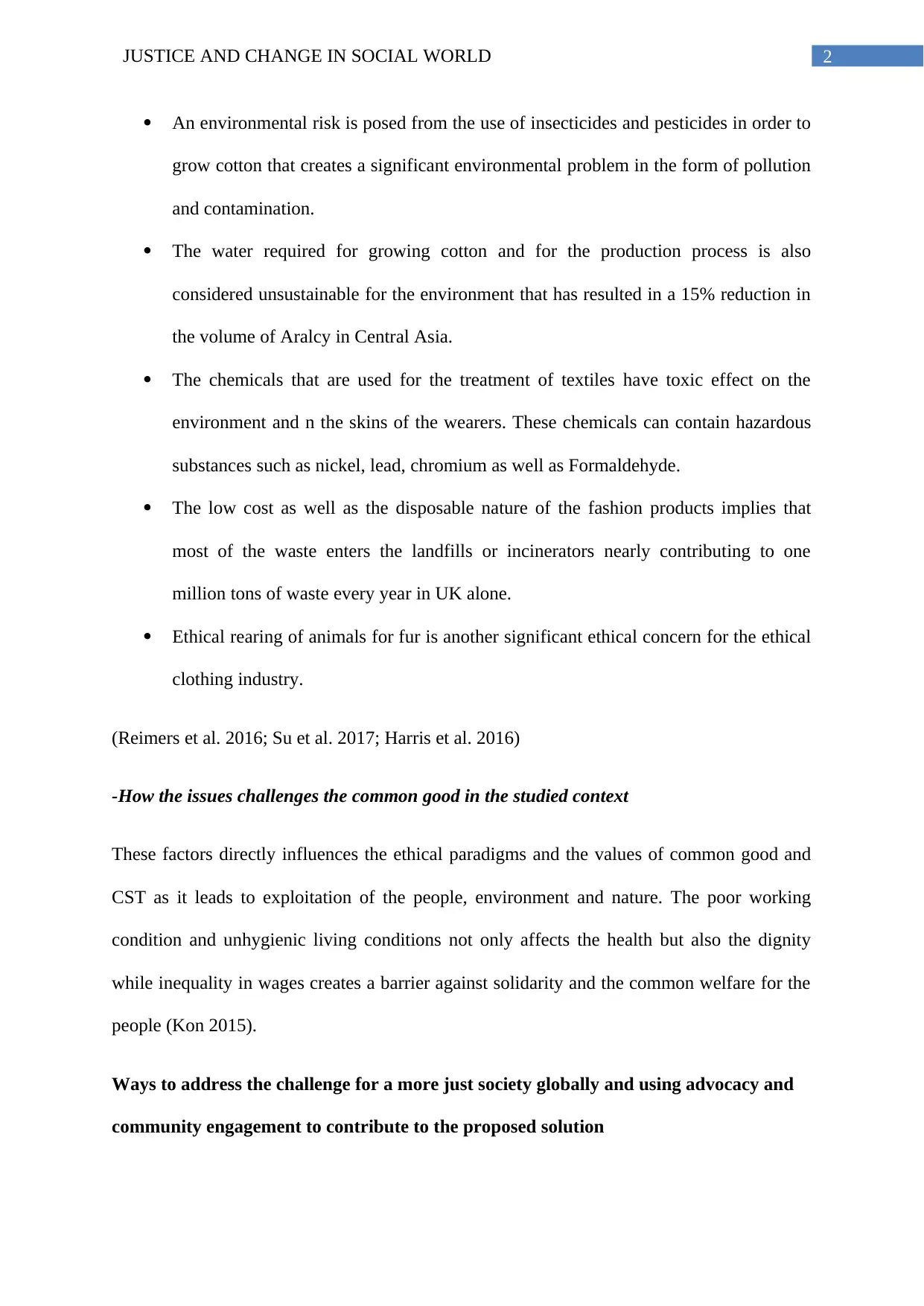
2JUSTICE AND CHANGE IN SOCIAL WORLD
An environmental risk is posed from the use of insecticides and pesticides in order to
grow cotton that creates a significant environmental problem in the form of pollution
and contamination.
The water required for growing cotton and for the production process is also
considered unsustainable for the environment that has resulted in a 15% reduction in
the volume of Aralcy in Central Asia.
The chemicals that are used for the treatment of textiles have toxic effect on the
environment and n the skins of the wearers. These chemicals can contain hazardous
substances such as nickel, lead, chromium as well as Formaldehyde.
The low cost as well as the disposable nature of the fashion products implies that
most of the waste enters the landfills or incinerators nearly contributing to one
million tons of waste every year in UK alone.
Ethical rearing of animals for fur is another significant ethical concern for the ethical
clothing industry.
(Reimers et al. 2016; Su et al. 2017; Harris et al. 2016)
-How the issues challenges the common good in the studied context
These factors directly influences the ethical paradigms and the values of common good and
CST as it leads to exploitation of the people, environment and nature. The poor working
condition and unhygienic living conditions not only affects the health but also the dignity
while inequality in wages creates a barrier against solidarity and the common welfare for the
people (Kon 2015).
Ways to address the challenge for a more just society globally and using advocacy and
community engagement to contribute to the proposed solution
An environmental risk is posed from the use of insecticides and pesticides in order to
grow cotton that creates a significant environmental problem in the form of pollution
and contamination.
The water required for growing cotton and for the production process is also
considered unsustainable for the environment that has resulted in a 15% reduction in
the volume of Aralcy in Central Asia.
The chemicals that are used for the treatment of textiles have toxic effect on the
environment and n the skins of the wearers. These chemicals can contain hazardous
substances such as nickel, lead, chromium as well as Formaldehyde.
The low cost as well as the disposable nature of the fashion products implies that
most of the waste enters the landfills or incinerators nearly contributing to one
million tons of waste every year in UK alone.
Ethical rearing of animals for fur is another significant ethical concern for the ethical
clothing industry.
(Reimers et al. 2016; Su et al. 2017; Harris et al. 2016)
-How the issues challenges the common good in the studied context
These factors directly influences the ethical paradigms and the values of common good and
CST as it leads to exploitation of the people, environment and nature. The poor working
condition and unhygienic living conditions not only affects the health but also the dignity
while inequality in wages creates a barrier against solidarity and the common welfare for the
people (Kon 2015).
Ways to address the challenge for a more just society globally and using advocacy and
community engagement to contribute to the proposed solution
⊘ This is a preview!⊘
Do you want full access?
Subscribe today to unlock all pages.

Trusted by 1+ million students worldwide
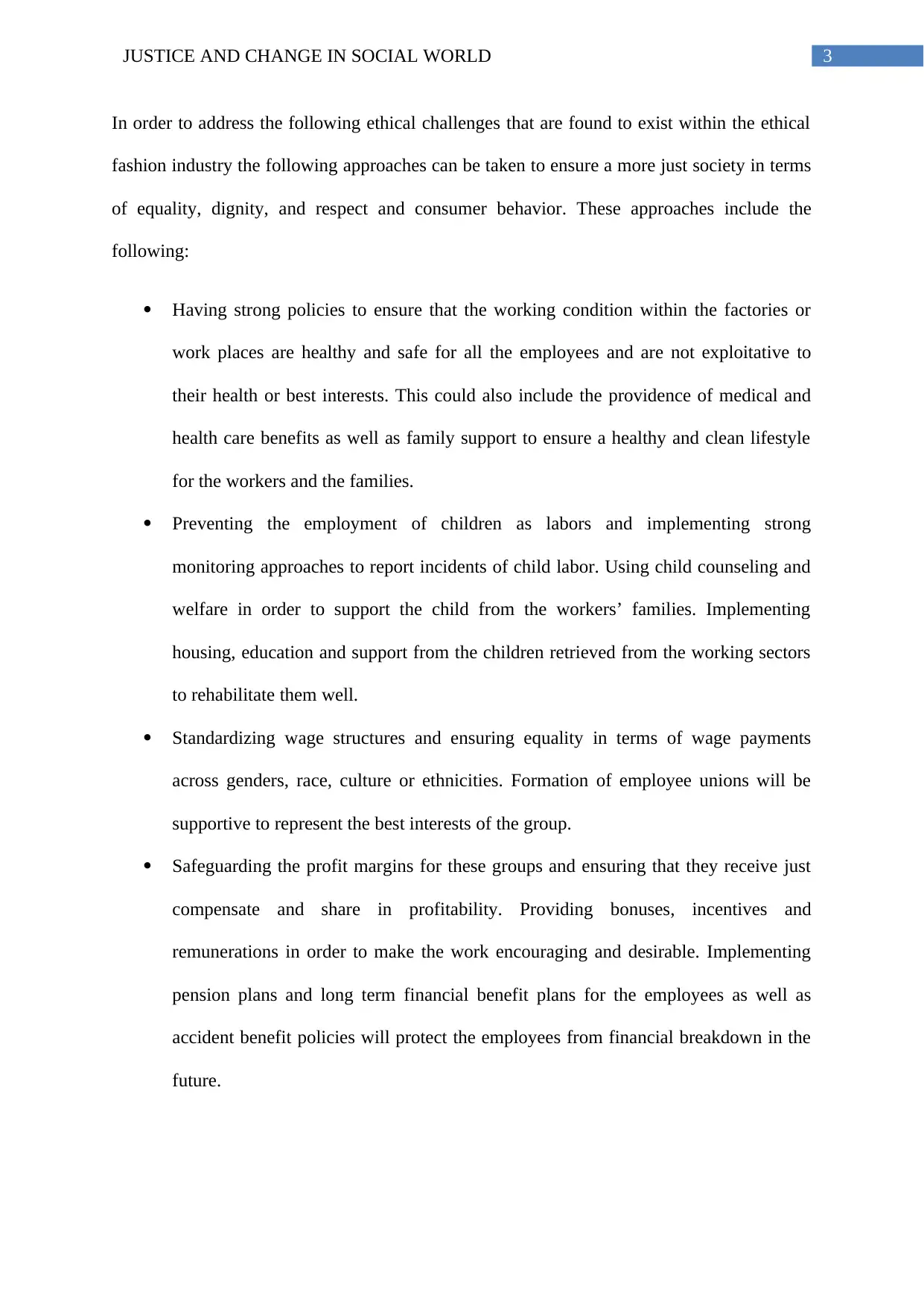
3JUSTICE AND CHANGE IN SOCIAL WORLD
In order to address the following ethical challenges that are found to exist within the ethical
fashion industry the following approaches can be taken to ensure a more just society in terms
of equality, dignity, and respect and consumer behavior. These approaches include the
following:
Having strong policies to ensure that the working condition within the factories or
work places are healthy and safe for all the employees and are not exploitative to
their health or best interests. This could also include the providence of medical and
health care benefits as well as family support to ensure a healthy and clean lifestyle
for the workers and the families.
Preventing the employment of children as labors and implementing strong
monitoring approaches to report incidents of child labor. Using child counseling and
welfare in order to support the child from the workers’ families. Implementing
housing, education and support from the children retrieved from the working sectors
to rehabilitate them well.
Standardizing wage structures and ensuring equality in terms of wage payments
across genders, race, culture or ethnicities. Formation of employee unions will be
supportive to represent the best interests of the group.
Safeguarding the profit margins for these groups and ensuring that they receive just
compensate and share in profitability. Providing bonuses, incentives and
remunerations in order to make the work encouraging and desirable. Implementing
pension plans and long term financial benefit plans for the employees as well as
accident benefit policies will protect the employees from financial breakdown in the
future.
In order to address the following ethical challenges that are found to exist within the ethical
fashion industry the following approaches can be taken to ensure a more just society in terms
of equality, dignity, and respect and consumer behavior. These approaches include the
following:
Having strong policies to ensure that the working condition within the factories or
work places are healthy and safe for all the employees and are not exploitative to
their health or best interests. This could also include the providence of medical and
health care benefits as well as family support to ensure a healthy and clean lifestyle
for the workers and the families.
Preventing the employment of children as labors and implementing strong
monitoring approaches to report incidents of child labor. Using child counseling and
welfare in order to support the child from the workers’ families. Implementing
housing, education and support from the children retrieved from the working sectors
to rehabilitate them well.
Standardizing wage structures and ensuring equality in terms of wage payments
across genders, race, culture or ethnicities. Formation of employee unions will be
supportive to represent the best interests of the group.
Safeguarding the profit margins for these groups and ensuring that they receive just
compensate and share in profitability. Providing bonuses, incentives and
remunerations in order to make the work encouraging and desirable. Implementing
pension plans and long term financial benefit plans for the employees as well as
accident benefit policies will protect the employees from financial breakdown in the
future.
Paraphrase This Document
Need a fresh take? Get an instant paraphrase of this document with our AI Paraphraser

4JUSTICE AND CHANGE IN SOCIAL WORLD
Using sustainable farming practices based on limited usage of pesticides and
insecticides and also educating the farmers on alternative farming strategies with the
usage of organic agents and minimizing the usage of chemicals.
Implementing strong practices of environmental assessment to evaluate the impact of
the farming practices on the environment as well as the health of the farmers. This
can ensure that the framing practices are safe for the environment and do not create
adverse impact for the eco system as well as human health.
Minimizing the usage of water for the farming purposes through better utilization of
water through strategies such as rain water harvesting, storm water harvesting and
preventing the depletion of ground water levels. Simultaneously it is also important
to have water treatment facilities for the treatment effluents from the factories before
being released into the environment to prevent contaminants such as heavy metals
and toxic chemicals to enter the eco system.
Utilizing other sources of fabric for the manufacture of clothing such as polyester,
polystyrene as well as recyclable materials such as bamboo, corn starch and hemp.
Also, recycled plastic products can be used for the creation of yarns and thereby help
to reduce the burden on cotton usage on one hand and also help to address the
problem of plastic pollution on the other.
Using natural products for the treatment of textiles for the industrial use in order to
minimize the environmental harm as well as the entry of toxic chemicals into the
clothing thereby preventing adverse health impacts.
Promoting reuse and recycling of the clothing materials in order to prevent them from
entering the landfills or being incinerated. This can ensure the reduction of millions
of tons of clothing waste every year and the emission of greenhouse gases from the
process of incineration.
Using sustainable farming practices based on limited usage of pesticides and
insecticides and also educating the farmers on alternative farming strategies with the
usage of organic agents and minimizing the usage of chemicals.
Implementing strong practices of environmental assessment to evaluate the impact of
the farming practices on the environment as well as the health of the farmers. This
can ensure that the framing practices are safe for the environment and do not create
adverse impact for the eco system as well as human health.
Minimizing the usage of water for the farming purposes through better utilization of
water through strategies such as rain water harvesting, storm water harvesting and
preventing the depletion of ground water levels. Simultaneously it is also important
to have water treatment facilities for the treatment effluents from the factories before
being released into the environment to prevent contaminants such as heavy metals
and toxic chemicals to enter the eco system.
Utilizing other sources of fabric for the manufacture of clothing such as polyester,
polystyrene as well as recyclable materials such as bamboo, corn starch and hemp.
Also, recycled plastic products can be used for the creation of yarns and thereby help
to reduce the burden on cotton usage on one hand and also help to address the
problem of plastic pollution on the other.
Using natural products for the treatment of textiles for the industrial use in order to
minimize the environmental harm as well as the entry of toxic chemicals into the
clothing thereby preventing adverse health impacts.
Promoting reuse and recycling of the clothing materials in order to prevent them from
entering the landfills or being incinerated. This can ensure the reduction of millions
of tons of clothing waste every year and the emission of greenhouse gases from the
process of incineration.
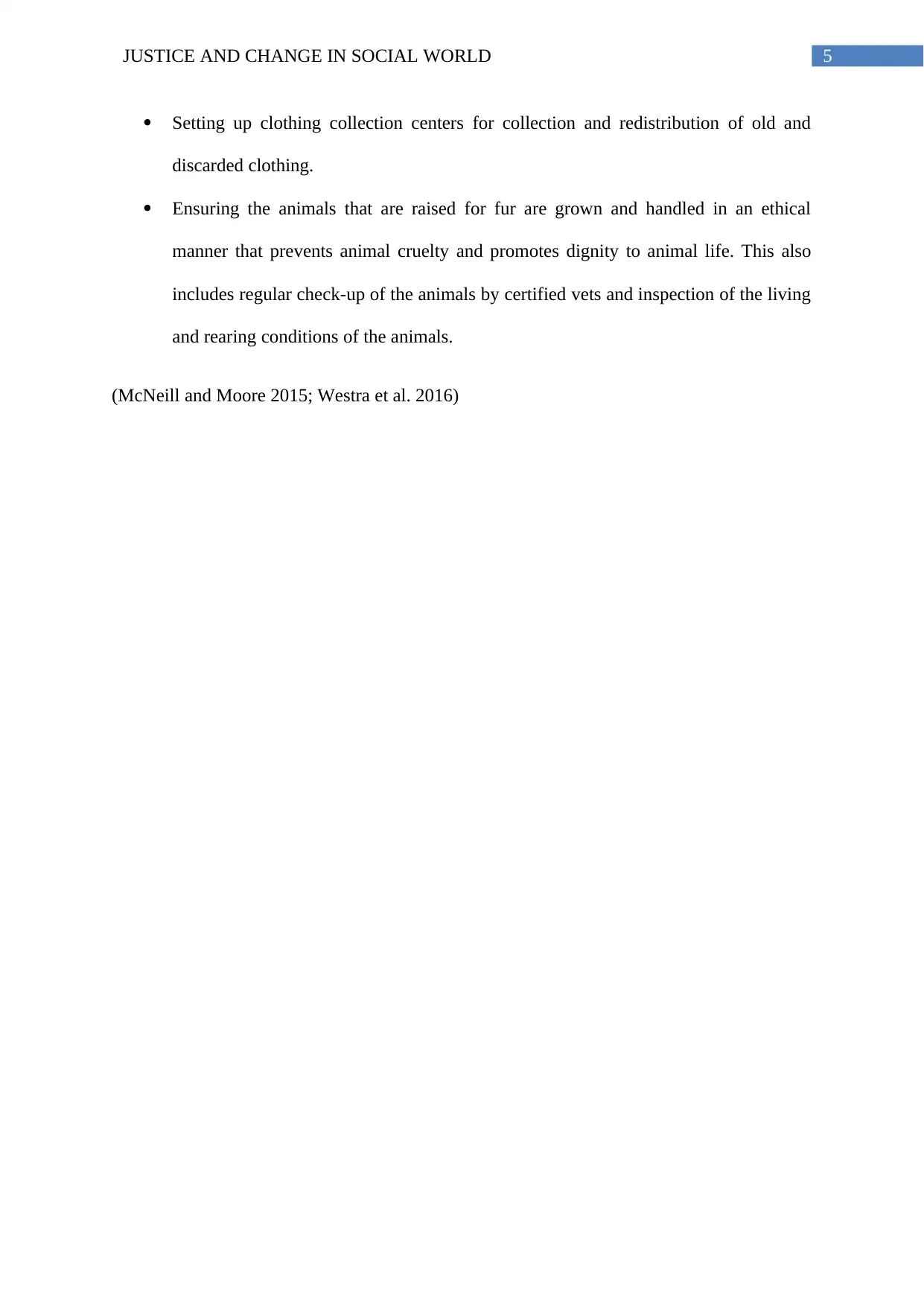
5JUSTICE AND CHANGE IN SOCIAL WORLD
Setting up clothing collection centers for collection and redistribution of old and
discarded clothing.
Ensuring the animals that are raised for fur are grown and handled in an ethical
manner that prevents animal cruelty and promotes dignity to animal life. This also
includes regular check-up of the animals by certified vets and inspection of the living
and rearing conditions of the animals.
(McNeill and Moore 2015; Westra et al. 2016)
Setting up clothing collection centers for collection and redistribution of old and
discarded clothing.
Ensuring the animals that are raised for fur are grown and handled in an ethical
manner that prevents animal cruelty and promotes dignity to animal life. This also
includes regular check-up of the animals by certified vets and inspection of the living
and rearing conditions of the animals.
(McNeill and Moore 2015; Westra et al. 2016)
⊘ This is a preview!⊘
Do you want full access?
Subscribe today to unlock all pages.

Trusted by 1+ million students worldwide
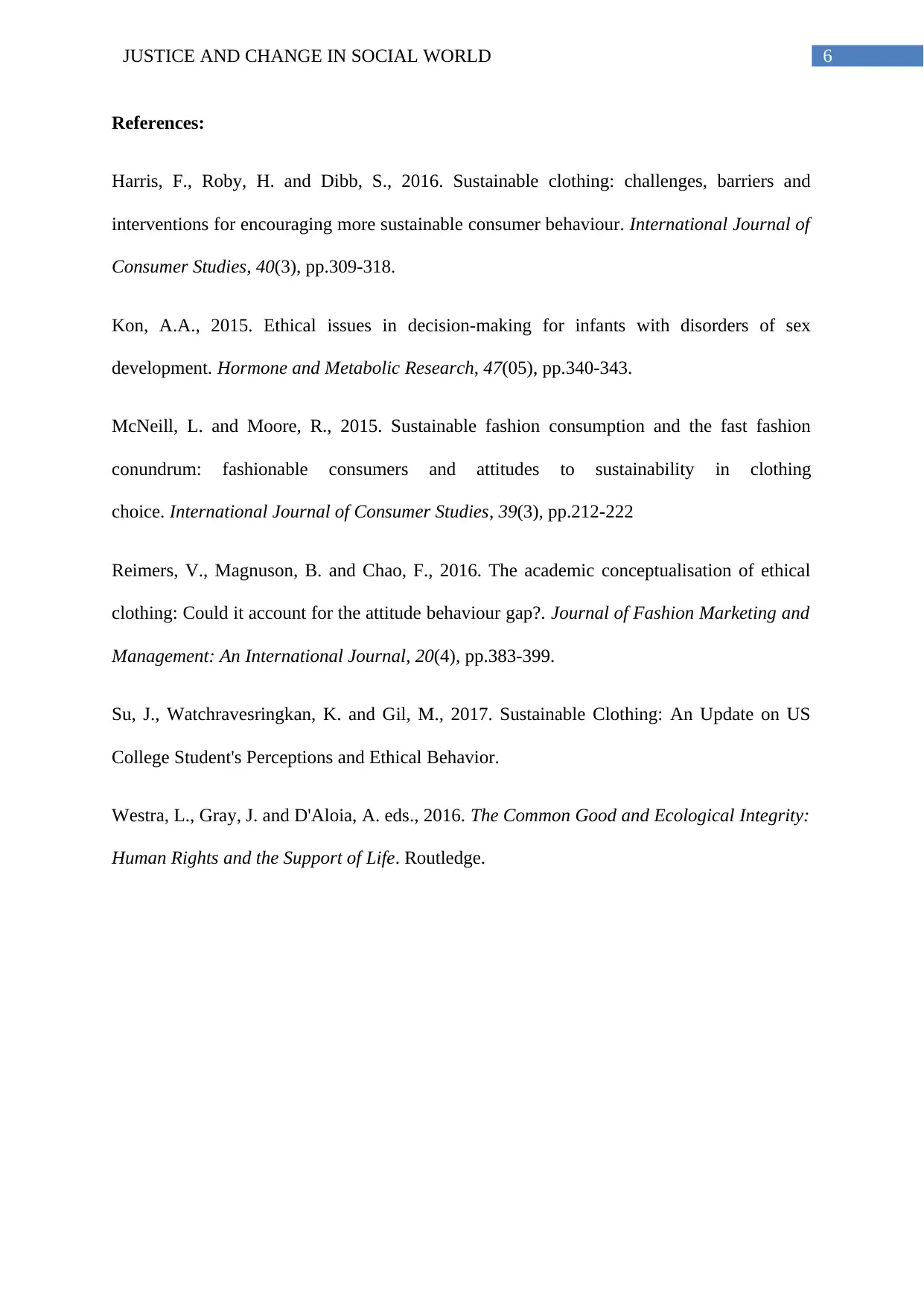
6JUSTICE AND CHANGE IN SOCIAL WORLD
References:
Harris, F., Roby, H. and Dibb, S., 2016. Sustainable clothing: challenges, barriers and
interventions for encouraging more sustainable consumer behaviour. International Journal of
Consumer Studies, 40(3), pp.309-318.
Kon, A.A., 2015. Ethical issues in decision-making for infants with disorders of sex
development. Hormone and Metabolic Research, 47(05), pp.340-343.
McNeill, L. and Moore, R., 2015. Sustainable fashion consumption and the fast fashion
conundrum: fashionable consumers and attitudes to sustainability in clothing
choice. International Journal of Consumer Studies, 39(3), pp.212-222
Reimers, V., Magnuson, B. and Chao, F., 2016. The academic conceptualisation of ethical
clothing: Could it account for the attitude behaviour gap?. Journal of Fashion Marketing and
Management: An International Journal, 20(4), pp.383-399.
Su, J., Watchravesringkan, K. and Gil, M., 2017. Sustainable Clothing: An Update on US
College Student's Perceptions and Ethical Behavior.
Westra, L., Gray, J. and D'Aloia, A. eds., 2016. The Common Good and Ecological Integrity:
Human Rights and the Support of Life. Routledge.
References:
Harris, F., Roby, H. and Dibb, S., 2016. Sustainable clothing: challenges, barriers and
interventions for encouraging more sustainable consumer behaviour. International Journal of
Consumer Studies, 40(3), pp.309-318.
Kon, A.A., 2015. Ethical issues in decision-making for infants with disorders of sex
development. Hormone and Metabolic Research, 47(05), pp.340-343.
McNeill, L. and Moore, R., 2015. Sustainable fashion consumption and the fast fashion
conundrum: fashionable consumers and attitudes to sustainability in clothing
choice. International Journal of Consumer Studies, 39(3), pp.212-222
Reimers, V., Magnuson, B. and Chao, F., 2016. The academic conceptualisation of ethical
clothing: Could it account for the attitude behaviour gap?. Journal of Fashion Marketing and
Management: An International Journal, 20(4), pp.383-399.
Su, J., Watchravesringkan, K. and Gil, M., 2017. Sustainable Clothing: An Update on US
College Student's Perceptions and Ethical Behavior.
Westra, L., Gray, J. and D'Aloia, A. eds., 2016. The Common Good and Ecological Integrity:
Human Rights and the Support of Life. Routledge.
1 out of 7
Related Documents
Your All-in-One AI-Powered Toolkit for Academic Success.
+13062052269
info@desklib.com
Available 24*7 on WhatsApp / Email
![[object Object]](/_next/static/media/star-bottom.7253800d.svg)
Unlock your academic potential
Copyright © 2020–2025 A2Z Services. All Rights Reserved. Developed and managed by ZUCOL.





